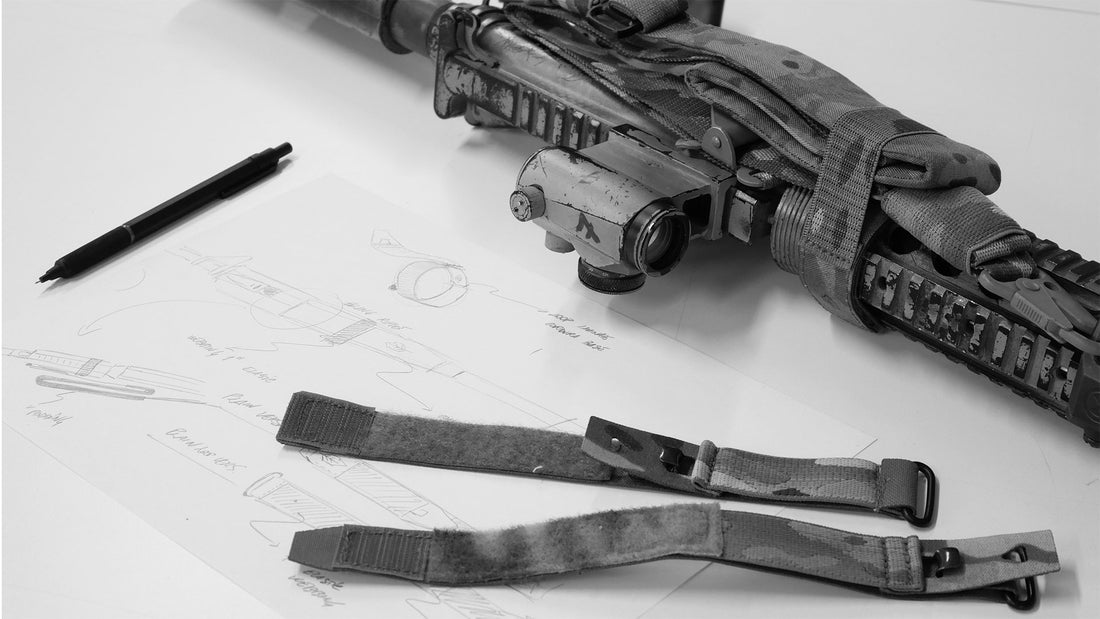
Share
R&D - SLING KEEPER
Andrea D.L.He's little, but he's mean!
In this first article of the R&D session, we will retrace the fundamental phases which led to the birth of our SLING Keeper: a simple product in terms of production but which gave us some difficulties during the development process. Finding the right compromise between ease of use and safety was our main challenge. Enjoy!

- An operational advantage for those who work inside vehicles or in tight places, where the weapon is not in direct contact with the operator. In critical situations in which we are called to reach and use our weapon, it is easy to understand that the sling can get stuck, if it is free to dangle.
- A logistic advantage to keep your equipment and weapons stowed in the right way. Approaching your duties with the right mind-set is a detail that can make the difference.
DEFINE
Clarifying the problems that a product must solve highlights its fundamental characteristics. For this reason we usually start from the first rule of design: define the problem!This prerogative, which might seem obvious, is actually very important, especially in the situations where the project tends to deadlock.
After a careful analysis we have defined three peculiarities that, in our opinion, a good SLING Keeper must have:
- Keep the sling in position to minimize the possibility of getting stuck, during handling.
- Having a simple and intuitive opening system, in order not to hinder the operator in stressful situations.
- Having a reliable opening system to prevent accidental detachment.
|
The first group of SLING Keeper enclose the models with magnetic opening. They are very intuitive and easy to open, but at the same time, not very reliable. Imagine taking the weapon, during a stressful situation, and accidentally hitting the magnet and disengaging it. Result: Point 3 is not solved, i.e. the goal of avoiding accidental opening is not reached. |
 |
| The second group encloses the models without an opening system. They consist of an elastic webbing (or cord) that wraps the rifle, under which we can stow the sling. In this case, the sling can only be extracted by "pulling it out", making the unfolding maneuver not very fluid. Result: Point 2 is not resolved, i.e. the goal of having a simple and intuitive opening system is not reached. |  |
DEVELOPMENT
Once we defined what our product had to solve and what were the proposals on the market, we focused the ideas, made sketches, outlined forms and solutions.

Once the CAD (Computer Aided Design) was created, the components were cut and everything was assembled, the 1st prototype was born.
During the first tests conducted in our workshop, critical points immediately emerged. We tried to solve them with subsequent revisions, up to the 4th (REV.4).

In this phase we have had the greatest difficulties. The product had adequate functionality, it can be adapted to most of the weapons on the market but it presented a big problem: when we tried to release the system it tended to rotate on its own axis, moreover the metal hook tended to get stuck, making the release maneuver not fluid. In the video below it is clear what has been said:
To solve these critical issues, we thought to add rubber material that would increase the friction between the SLING Keeper and the rifle but, in addition to increasing production costs, it would not guarantee functionality in rainy conditions or in marine environments. We took a few days to understand how to proceed.
TURNING POINT

Reflecting on the three initial points, we understood that the solution was to replace the opening system. Made with a snap button, the new prototype featured a very fluid opening. Furthermore, the rotation problem was also solved because the force impressed to open the button took place perpendicular to the weapon. In the video below you can see how perfectly works the REV.5:
Before concluding the development process we sent the SLING Keeper, to operators and friends, for field tests. We have also created a summary table in order to support, with empirical data, the validity of our choice. As you can see in the image below, we reported the features to be evaluated and assigned a score, from 0 to 10, for each review we carried out. The final model (REV.5) reached the highest score: 46 points out of 50.

We did not expect to find difficulties in developing such a simple, almost banal product ... and maybe that's what we love about our job! We are very satisfied with the final result because we have reached a product capable of solving a real problem in the simplest and most intuitive way possible!
As the great designer Bruno Munari said: "Complicating is easy, simplifying is complicated ..."

I suggest readers to leave a comment in the section below, both for questions and to understand if the article was to your liking. Your feedback will be essential to improve future posts and make them more enjoyable!
I take this opportunity to thank you all for your attention and wish you the best for the new year!
Ad maiora!
